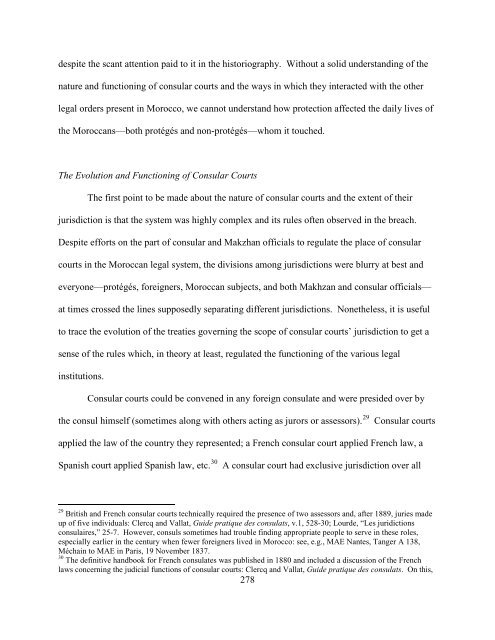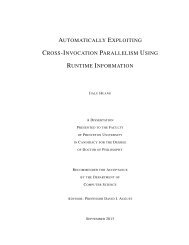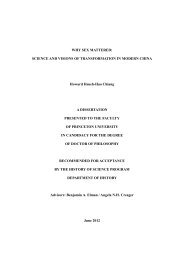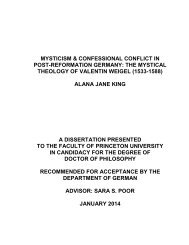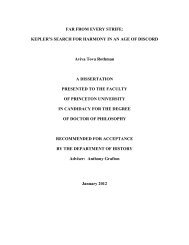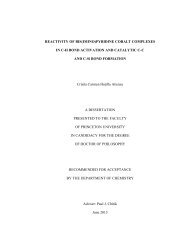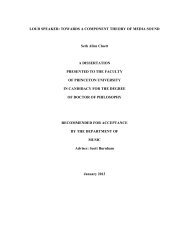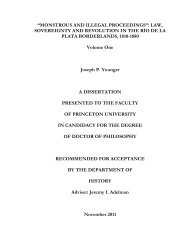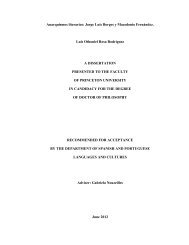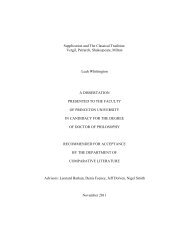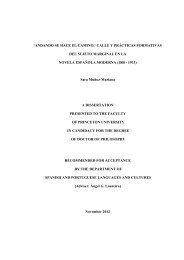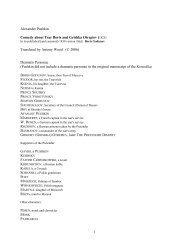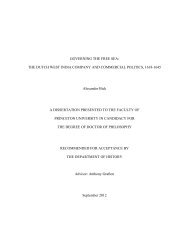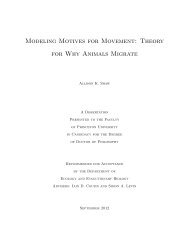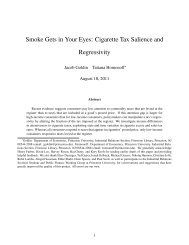- Page 1 and 2:
IN THE COURTS OF THE NATIONS: JEWS,
- Page 3 and 4:
Abstract This dissertation examines
- Page 5 and 6:
Table of Contents Abstract………
- Page 7 and 8:
throughout the process was vital to
- Page 9 and 10:
and Arielle Rubenstein, Stephanie S
- Page 11 and 12:
Introduction This dissertation exam
- Page 13 and 14:
on the internal history of the Jewi
- Page 15 and 16:
cases they made up close to half of
- Page 17 and 18:
study of law in the Islamic world w
- Page 19 and 20:
of these institutions remain opaque
- Page 21 and 22:
and, for some individuals, appealin
- Page 23 and 24:
actors with agency and to understan
- Page 25 and 26:
many of those who espouse the neo-l
- Page 27 and 28:
In recent years, the neo-lachrymose
- Page 29 and 30:
alternative framework to that of au
- Page 31 and 32:
including courts—which were of pr
- Page 33 and 34:
Recently scholars working on the me
- Page 35 and 36:
We are left with two models of Jewi
- Page 37 and 38:
Legal pluralism is an approach to u
- Page 39 and 40:
orders. I also turn the focus from
- Page 41 and 42:
Nonetheless, the tendency of forum
- Page 43 and 44:
Legal pluralism does not explain wh
- Page 45 and 46:
Jewish communities were no less var
- Page 47 and 48:
is perhaps best attested by the fac
- Page 49 and 50:
To help remind readers that the thr
- Page 51 and 52:
abusive Makhzan officials, infringe
- Page 53 and 54:
Chapter One: Between Batei Din and
- Page 55 and 56:
went to batei din and sharī‘a co
- Page 57 and 58:
school relevant for our purposes is
- Page 59 and 60:
Jewish and Islamic legal systems re
- Page 61 and 62:
ehind, a large number were undoubte
- Page 63 and 64:
atei din generally, it does reflect
- Page 65 and 66:
Jews used batei din not only as not
- Page 67 and 68:
Jerusalem. 33 The collection consis
- Page 69 and 70:
(azraqu al-‘aynayn)—a trait for
- Page 71 and 72:
undoubtedly made much of their mone
- Page 73 and 74:
preventing members of the community
- Page 75 and 76:
‘udūl. 76 These ‘udūl, whose
- Page 77 and 78:
Eliyahu b. Ya'aqov Zohra bat Ya‘a
- Page 79 and 80:
and Muḥammad would return the mon
- Page 81 and 82:
Table 2.1 Types of Entries 2% 2% 2%
- Page 83 and 84:
allegation or deposition in a case
- Page 85 and 86:
court approximately once a week, ei
- Page 87 and 88:
The introduction of the “protecti
- Page 89 and 90:
ule; the ‘udūl almost always too
- Page 91 and 92:
documents would stand up as evidenc
- Page 93 and 94:
Empire. 49 A document in the Assarr
- Page 95 and 96:
legal procedure was relatively mino
- Page 97 and 98:
een optional as not all bills of de
- Page 99 and 100:
Qa‘da 1309 (June 12, 1892), two
- Page 101 and 102:
mostly meant extending credit on go
- Page 103 and 104:
Other release documents specify tha
- Page 105 and 106:
al-faqīh Aḥmad al-Filālī al-Ma
- Page 107 and 108:
Lease contracts, on the other hand,
- Page 109 and 110:
which was operated by Muslims durin
- Page 111 and 112:
Shalom’s knowledge of Islamic law
- Page 113 and 114:
elow). Although the majority of law
- Page 115 and 116:
weeks after the plaintiff filed the
- Page 117 and 118:
gathered twelve men who testified t
- Page 119 and 120:
whether the qāḍī accepted al-
- Page 121 and 122:
in the Assarraf collection indicate
- Page 123 and 124:
(ittifāqīyan) and were testifying
- Page 125 and 126:
In another instance of oath avoidan
- Page 127 and 128:
Sharī‘a courts provided a crucia
- Page 129 and 130:
agreement notarized according to Is
- Page 131 and 132:
ability and desire to move among di
- Page 133 and 134:
‘udūl. 14 Most real estate trans
- Page 135 and 136:
equire or benefit from adjudication
- Page 137 and 138:
Simultaneous Use of Jewish and Isla
- Page 139 and 140:
evidence from the nineteenth centur
- Page 141 and 142:
to sue other Jews in sharī‘a cou
- Page 143 and 144:
But what about intra-Jewish lawsuit
- Page 145 and 146:
ut for the most part this is a here
- Page 147 and 148:
the sum of three duoros per month.
- Page 149 and 150:
only in Jewish law. This happened i
- Page 151 and 152:
in the millāḥ of Marrakesh on Ap
- Page 153 and 154:
aware of Jewish law and sometimes t
- Page 155 and 156:
of a rabbi to determine the proper
- Page 157 and 158:
‘Aṭṭār, in order to find out
- Page 159 and 160:
Muslims’ jurisdictional boundary
- Page 161 and 162:
that they had successfully done so.
- Page 163 and 164:
the Moroccan legal system more broa
- Page 165 and 166:
translated as the territories under
- Page 167 and 168:
elatively scant work on the legal h
- Page 169 and 170:
law, even if they did not consisten
- Page 171 and 172:
abrupt end after his death, as the
- Page 173 and 174:
put it, “in all medieval Muslim s
- Page 175 and 176:
about its image in the eyes of fore
- Page 177 and 178:
an injustice or an act of oppressio
- Page 179 and 180:
In designing its new army, the Makh
- Page 181 and 182:
The Ministry itself, although in co
- Page 183 and 184:
Minister of Complaints, a man about
- Page 185 and 186:
It is not entirely clear whether th
- Page 187 and 188:
initial letters. 102 The convention
- Page 189 and 190:
whether the sultan simply failed to
- Page 191 and 192:
Chapter Five: Appeals to the Minist
- Page 193 and 194:
Jews and the Ministry of Complaints
- Page 195 and 196:
The nature of these sources prevent
- Page 197 and 198:
Causes for Complaint Most of the ap
- Page 199 and 200:
products (such as barley). 23 This,
- Page 201 and 202:
appears numerous times). 29 While t
- Page 203 and 204:
matter what their religious backgro
- Page 205 and 206:
when amounts are specified they ten
- Page 207 and 208:
cases which were ultimately settled
- Page 209 and 210:
Jews who had been robbed. 62 The su
- Page 211 and 212:
from July 28, 1892, a group of Jews
- Page 213 and 214:
nature of sharī‘a courts. 83 In
- Page 215 and 216:
legal proof of his claim. 91 It is
- Page 217 and 218:
the Jewish victims were compensated
- Page 219 and 220:
central government could only do so
- Page 221 and 222:
and Muslim was responsible for arra
- Page 223 and 224:
sometimes the Makhzan officials’
- Page 225 and 226:
A more formidable obstacle to settl
- Page 227 and 228:
The Jewish creditor, however, reque
- Page 229 and 230:
The practice of exaggerating the va
- Page 231 and 232:
official accused a Jew of falsifyin
- Page 233 and 234:
esolve disputes with their Jewish d
- Page 235 and 236:
property. 178 In this case, the Mak
- Page 237 and 238: Chapter Six: Collective Appeals to
- Page 239 and 240: frequency of Jews’ petitions acro
- Page 241 and 242: The concentration of petitions duri
- Page 243 and 244: “right”—as in, the rights to
- Page 245 and 246: merchants serve as judges on a rota
- Page 247 and 248: Makhzan officials at times evoked t
- Page 249 and 250: The evidence of Jews’ appeals to
- Page 251 and 252: governor). 46 The next winter the J
- Page 253 and 254: along with a legal document contain
- Page 255 and 256: Following this escalation of violen
- Page 257 and 258: The governor of Debdou similarly pr
- Page 259 and 260: custom and the sultan’s command.
- Page 261 and 262: minister of foreign affairs, receiv
- Page 263 and 264: Yet murder cases were not the only
- Page 265 and 266: Moroccan legal system. On the one h
- Page 267 and 268: In 1884 the Jews of Fez appealed to
- Page 269 and 270: Although at first these appeals mig
- Page 271 and 272: The Jews of Meknes appealed to the
- Page 273 and 274: In other instances, Makhzan officia
- Page 275 and 276: about their own coreligionists. The
- Page 277 and 278: Europeans—a sentiment that at oth
- Page 279 and 280: complain about their muḥtasib, em
- Page 281 and 282: Chapter Seven: Foreign Protection a
- Page 283 and 284: Perhaps most important, however, is
- Page 285 and 286: of consular courts functioned throu
- Page 287: of Muslims from becoming protégés
- Page 291 and 292: of consular courts by specifying th
- Page 293 and 294: an important moment in the history
- Page 295 and 296: were required to notify their consu
- Page 297 and 298: dealt with cases by means other tha
- Page 299 and 300: In other instances, consuls wrote t
- Page 301 and 302: qāḍī” attesting a debt owed t
- Page 303 and 304: The following two chapters examine
- Page 305 and 306: clarify when and why he had taken t
- Page 307 and 308: Even scholars who argue against see
- Page 309 and 310: ecognize their contract since “th
- Page 311 and 312: of the individuals concerned. 31 Pr
- Page 313 and 314: concerning the incident, which they
- Page 315 and 316: speculated that the reluctance of t
- Page 317 and 318: protection) of Yitzḥaq b. Nissim
- Page 319 and 320: cooperate with foreigners’ reques
- Page 321 and 322: Dinar Ohana), an American protégé
- Page 323 and 324: Jews tried to ensure a fortuitous o
- Page 325 and 326: ordered Assayag to stop paying Zagu
- Page 327 and 328: efused. 100 Faced with this dead en
- Page 329 and 330: claimed that Emsellem had no right
- Page 331 and 332: number of foreign subjects and prot
- Page 333 and 334: By subjecting the suit to Moroccan
- Page 335 and 336: sued Mas‘ūd al-Shayẓamī (Meso
- Page 337 and 338: Foreign subjects and protégés wer
- Page 339 and 340:
confirmed that this meant the Jews
- Page 341 and 342:
AIU’s attention either through pe
- Page 343 and 344:
A competing narrative of Moroccan J
- Page 345 and 346:
non-Jewish Westerners alike, I argu
- Page 347 and 348:
international press. Demnat might s
- Page 349 and 350:
attribute the Makhzan’s efforts t
- Page 351 and 352:
The events in Demnat were not the o
- Page 353 and 354:
finally wrote to Muḥammad Bargās
- Page 355 and 356:
wearing Muslim clothing and told hi
- Page 357 and 358:
of 1863. Four Jews were accused of
- Page 359 and 360:
made an honest mistake, the effect
- Page 361 and 362:
etracted his initial testimony clai
- Page 363 and 364:
the remaining two subjects. Only af
- Page 365 and 366:
organizations, and the foreign pres
- Page 367 and 368:
Marseillais, The Times, The Pall Ma
- Page 369 and 370:
coreligionists’ position. 112 Avn
- Page 371 and 372:
had been following the standard pra
- Page 373 and 374:
did not declare that Jews and Musli
- Page 375 and 376:
under the jurisdiction of Makhzan o
- Page 377 and 378:
tolerance. 142 Such a policy would
- Page 379 and 380:
concede to the American ambassador
- Page 381 and 382:
Epilogue On March 30, 1912, France
- Page 383 and 384:
courts to matters of personal statu
- Page 385 and 386:
This sort of continuity in legal pr
- Page 387 and 388:
intra-Jewish cases to these courts
- Page 389 and 390:
Glossary of Arabic and Hebrew Terms
- Page 391 and 392:
Ẓahīr: Royal decree (spelled “
- Page 393 and 394:
United States: United States Nation
- Page 395 and 396:
———. Kitāb al-istiqṣā li-
- Page 397 and 398:
Becker, Jerónimo. España y Marrue
- Page 399 and 400:
Chetrit, Joseph. Diglossie, hybrida
- Page 401 and 402:
Ennaji, Mohammed. Expansion europé
- Page 403 and 404:
Gotzmann, Andreas. “At Home in Ma
- Page 405 and 406:
———. Les protégés : contrib
- Page 407 and 408:
Marcus, Abraham. The Middle East on
- Page 409 and 410:
Perron, M. Précis de jurisprudence
- Page 411 and 412:
———. “Forum Shopping Among
- Page 413:
Cultural Dimensions, edited by Mich


